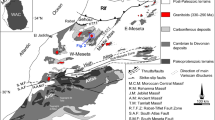Abstract
Deccan Trap lavas (Cretaceous to Tertiary), which cover a large area in the Western and the Central India, are generally regarded as structurally undisturbed save for certain areas along the west-coast and the Narmada Valley in Central India.
Remote Sensing techniques have given a new dimension to the problem of locating such disturbed areas by virtue of the capacity of aerospace imagery to delineate lineaments, many of which represent structural geological features.
Studies carried out in the areas west and north west of Pune, (above and below the western ghat scrap), the Narmada valley region north of Barwah and the Ramakona area of Central India, reveal that these areas are riddled with fractures. The fractures have generally given rise to narrow valley or escarpments. Some of the fractures show displacement along them, while some show intrusive dykes filling them.
The fractures in Central India were sometimes found to the extensions of faults traversing the basement. Hence, in the regoins, where the basement is not exposed, they may be suggestive of the structural trends of the concealed basement.
Similar content being viewed by others
References
Auden, J.B. (1949) Dykes in western India; Trans. Nat. Inst. Science India; vol:3; pp:123–157.
Gupta, V.J. (1976) Indian Cainozoic Stratigraphy; Hindustan Publ. Corp., New Delhi; pp:1–144.
Kale, V.S. (1981) Geology of the Choral area, Indore district, Madhya Pradesh; Unpubl. M.Sc. Dissertation Thesis; Poona University; pp:1–80.
Kale, V.S. and Mudholkar, A.V. (1982) Reactivation of the Narmada-Son Lineament in Post-Trappean times: Evidences from the Choral area, Indore district, M.P.; (Abstract). Paper presented at: Seminar on the Indian Lithosphere: Structure & Evolution; Pune; pp:24–25.
Kale, V.S. and Peshwa, V.V. (1982d) Structurally controlled drainage of the. Choral area, Indore district (M.P): A study based on aerial photointerpretation; (Abstract). Paper presented at 3rd. Ann. Indian Geographer’s Meet; Pune; pp:4–5.
Krishnan, ^M.S. (1968) Geology of India and Burma: (5th Ed.) Higginbothams (Pvt.) Ltd.; pp:1–536
Mulay, J.G. (1980) Geology of the area around Khandala (Maharashtra) India, with special reference to Remote Sensing; Unpubl. Ph.D. Thesis: Poona Univ.; pp:1–203.
Mulay, J.G. and Peshwa, V.V. (1978) Fracture control on the drainage pattern of the area south of Lonavala and Khandala (Maharashtra) Proc. Symp. Morphology & Evolution of Landforms; Delhi Univ.; pp:222–225.
Peshwa, V.V. and Mulay, J.G. (1983) Remote sensing of dyke lineaments in Deccan Traps around Khandala and Khopoli, Maharashtra, India (in: Eds. Phadke and Phansalkar). Prof. Kelkar Memorial Volume; I.S.E.S.; pp: 201–206.
Peshwa, V.V. and Thigale, S.S. (1976) On the photogeological interpretation of post-Deccan Trap faulting, Kelod area, Nagpur district, Maharashtra; Paper presented at: Sem. and Gp. Dissc.: Role of Photointerpretation and Remote Sensing in Natural Resources Surveys; Nagpur.
Phadke, A.V. (1975) Geology of the Ramakona area, Chhindwara district, M.P.; Unpubl. Ph.D. Thesis; Poona Univ.; pp:1–175.
Rasker, R.S. (1980) Precambrian Geology of the Sausar area, Central India; Unpubl. Ph.D. Thesis; Poona Univ.; 1–180.
West, W.D., (1959) The source of the Deccan Trap flows; Jour. Geol. Soc. India; Vol. 1; No:1: pp:44–52.
Author information
Authors and Affiliations
About this article
Cite this article
Peshwa, V.V., Mulay, J.G. & Kale, V.S. Fracture zones in the Deccan Traps of Western and Central India: A study based on remote sensing techniques. J Indian Soc Remote Sens 15, 9–17 (1987). https://doi.org/10.1007/BF03003664
Issue Date:
DOI: https://doi.org/10.1007/BF03003664




